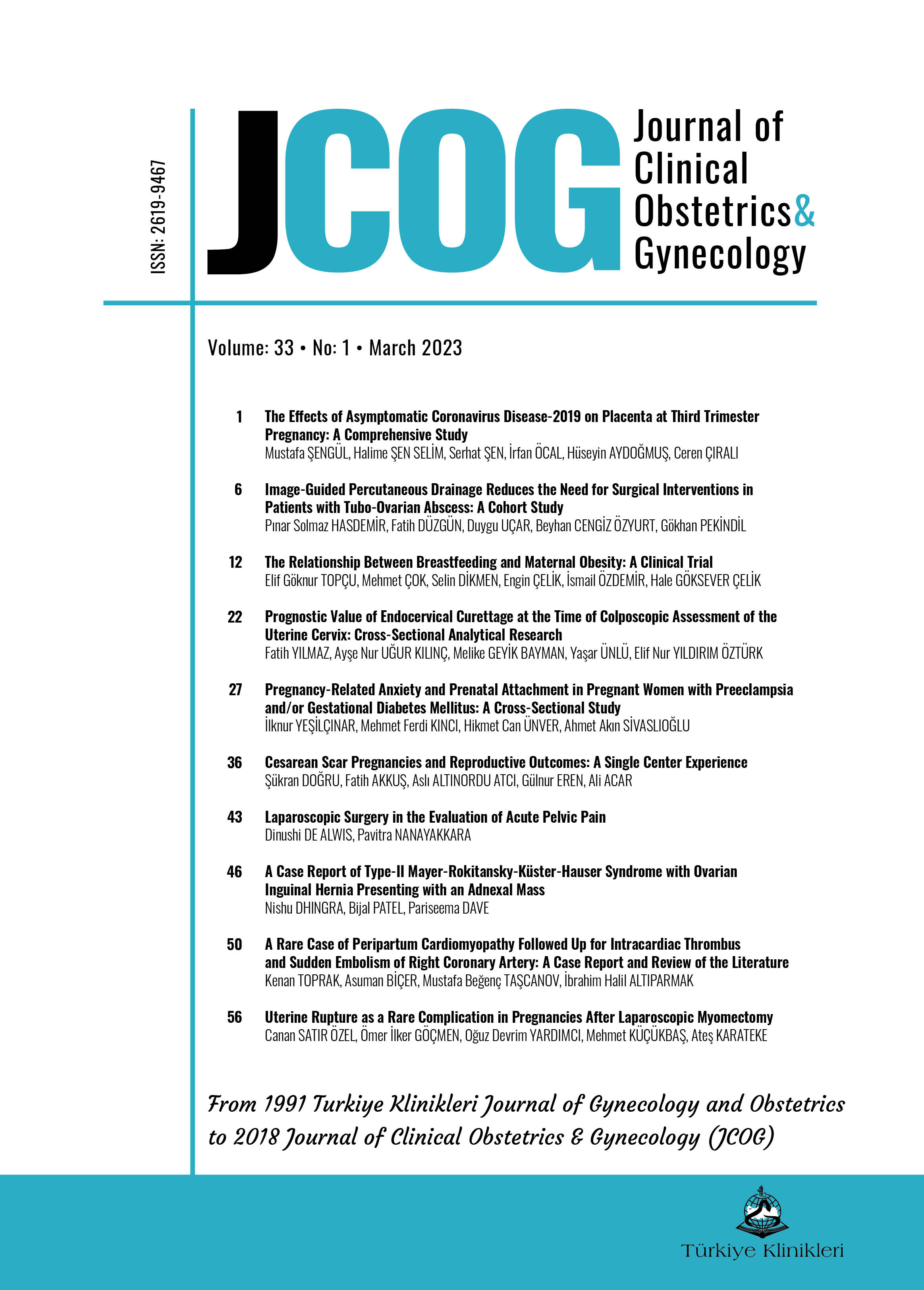Open Access
Peer Reviewed
ORIGINAL RESEARCH
1876 Viewed1584 Downloaded
Image-Guided Percutaneous Drainage Reduces the Need for Surgical Interventions in Patients with Tubo-Ovarian Abscess: A Cohort Study
Received: 04 May 2022 | Received in revised form: 27 Aug 2022
Accepted: 04 Nov 2022 | Available online: 16 Nov 2022
JCOG. 2023;33(1):6-11
DOI: 10.5336/jcog.2022-91113
Article Language: EN
Article Language: EN
Copyright Ⓒ 2025 by Türkiye Klinikleri. This is an open access article under the CC BY-NC-ND license (http://creativecommons.org/licenses/by-nc-nd/4.0/)
ABSTRACT
Objective: Management of tubo-ovarian abscess (TOA) is a challenging healthcare problem especially in reproductive age women. The aim of this study is to determine the current role of image-guided primary percutaneous drainage in avoidance of surgical intervention in the management of TOA. Material and Methods: A total of 76 patients hospitalized in our tertiary care center with the diagnosis of TOA were retrospectively evaluated. The study population was divided into 2 groups based on the treatment modalities as antibiotic treatment (n=48) and image-guided percutaneous drainage (n=28) and evaluated in terms of clinical and laboratory characteristics and the requirement for surgical intervention. Results: Surgical intervention was required in 1 (3.6%) patient treated with percutaneous drainage and in 10 (20.8%) patients treated with antibiotics (p=0.036). The choice of treatment modality was independent of demographic characteristics, clinical and laboratory findings. The size of TOA in percutaneous drainage group was significantly larger compared to the antibiotic treatment group (mean 6.75±1.886 cm versus 5.92±5.88 cm, respectively, p=0.047). Rehospitalization during follow-up was higher among patients treated with antibiotics only compared to percutaneous drainage group (p=0.06). Conclusion: Percutaneous drainage is an acceptable treatment option including large-sized TOA and decreases the requirement of surgical intervention in selected cases.
Objective: Management of tubo-ovarian abscess (TOA) is a challenging healthcare problem especially in reproductive age women. The aim of this study is to determine the current role of image-guided primary percutaneous drainage in avoidance of surgical intervention in the management of TOA. Material and Methods: A total of 76 patients hospitalized in our tertiary care center with the diagnosis of TOA were retrospectively evaluated. The study population was divided into 2 groups based on the treatment modalities as antibiotic treatment (n=48) and image-guided percutaneous drainage (n=28) and evaluated in terms of clinical and laboratory characteristics and the requirement for surgical intervention. Results: Surgical intervention was required in 1 (3.6%) patient treated with percutaneous drainage and in 10 (20.8%) patients treated with antibiotics (p=0.036). The choice of treatment modality was independent of demographic characteristics, clinical and laboratory findings. The size of TOA in percutaneous drainage group was significantly larger compared to the antibiotic treatment group (mean 6.75±1.886 cm versus 5.92±5.88 cm, respectively, p=0.047). Rehospitalization during follow-up was higher among patients treated with antibiotics only compared to percutaneous drainage group (p=0.06). Conclusion: Percutaneous drainage is an acceptable treatment option including large-sized TOA and decreases the requirement of surgical intervention in selected cases.
KEYWORDS: Abdominal abscess; diagnostic imaging; drainage; pelvic infection; gynecologic surgical treatment
REFERENCES:
- Cho HW, Koo YJ, Min KJ, Hong JH, Lee JK. Pelvic inflammatory disease in virgin women with tubo-ovarian abscess: a single-center experience and literature review. J Pediatr Adolesc Gynecol. 2017;30(2):203-8. [Crossref] [PubMed]
- Dewitt J, Reining A, Allsworth JE, Peipert JF. Tuboovarian abscesses: is size associated with duration of hospitalization & complications? Obstet Gynecol Int. 2010;2010:847041. [Crossref] [PubMed] [PMC]
- Fei YF, Lawrence AE, McCracken KA. Tubo-ovarian abscess in non-sexually active adolescent girls: a case series and literature review. J Pediatr Adolesc Gynecol. 2021;34(3):328-33. [Crossref] [PubMed]
- Munro K, Gharaibeh A, Nagabushanam S, Martin C. Diagnosis and management of tubo-ovarian abscesses. The Obstetrician & Gynaecologist. 2018;20(1):11-9. [Crossref]
- Kaplan AL, Jacobs WM, Ehresman JB. Aggressive management of pelvic abscess. Am J Obstet Gynecol. 1967;98(4):482-7. [Crossref] [PubMed]
- Levenson RB, Pearson KM, Saokar A, Lee SI, Mueller PR, Hahn PF. Image-guided drainage of tuboovarian abscesses of gastrointestinal or genitourinary origin: a retrospective analysis. J Vasc Interv Radiol. 2011;22(5):678-86. [Crossref] [PubMed]
- Seldinger SI. Catheter replacement of the needle in percutaneous arteriography; a new technique. Acta Radiol. 1953;39(5):368-76. [Crossref] [PubMed]
- Landers DV, Sweet RL. Tubo-ovarian abscess: contemporary approach to management. Rev Infect Dis. 1983;5(5):876-84. [Crossref] [PubMed]
- Ikeda M, Takahashi T, Kurachi H. Spontaneous perforation of pyometra: a report of seven cases and review of the literature. Gynecol Obstet Invest. 2013;75(4):243-9. [Crossref] [PubMed]
- Hakim J, Childress KJ, Hernandez AM, Bercaw-Pratt JL. Tubo-ovarian abscesses in nonsexually active adolescent females: a large case series. J Adolesc Health. 2019;65(2):303-5. [Crossref] [PubMed]
- Wong TTC, Lau HCQ, Tan TC. Retrospective study on the efficacy and prognostic factors of conservative versus drainage of tubo-ovarian abscesses. Arch Gynecol Obstet. 2020;302(3):679-83. [Crossref] [PubMed]
- Zhu S, Ballard E, Khalil A, Baartz D, Amoako A, Tanaka K. Impact of early surgical management on tubo-ovarian abscesses. J Obstet Gynaecol. 2021;41(7):1097-101. [Crossref] [PubMed]
- Buchweitz O, Malik E, Kressin P, Meyhoefer-Malik A, Diedrich K. Laparoscopic management of tubo-ovarian abscesses: retrospective analysis of 60 cases. Surg Endosc. 2000;14(10):948-50. [Crossref] [PubMed]
- Goje O, Markwei M, Kollikonda S, Chavan M, Soper DE. Outcomes of minimally invasive management of tubo-ovarian abscess: a systematic review. J Minim Invasive Gynecol. 2021;28(3):556-64. [Crossref] [PubMed]
- Gjelland K, Ekerhovd E, Granberg S. Transvaginal ultrasound-guided aspiration for treatment of tubo-ovarian abscess: a study of 302 cases. Am J Obstet Gynecol. 2005;193(4):1323-30. [Crossref] [PubMed]
- Goharkhay N, Verma U, Maggiorotto F. Comparison of CT- or ultrasound-guided drainage with concomitant intravenous antibiotics vs. intravenous antibiotics alone in the management of tubo-ovarian abscesses. Ultrasound Obstet Gynecol. 2007;29(1):65-9. [Crossref] [PubMed]
MENU
POPULAR ARTICLES
MOST DOWNLOADED ARTICLES





This journal is licensed under a Creative Commons Attribution-NonCommercial-NoDerivatives 4.0 International License.










